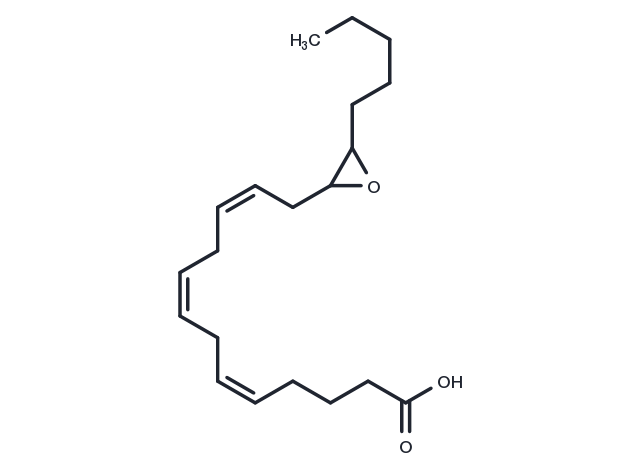Powder: -20°C for 3 years | In solvent: -80°C for 1 year


(±)14(15)-EET is a metabolite of arachidonic acid that is formed via epoxidation of arachidonic acid by cytochrome P450.[1],[2] It prevents increases in leukotriene B4, ICAM-1, and chemokine (C-C motif) ligand 1 (CCL2) induced by oxidized LDL in primary rat pulmonary artery endothelial cells (RPAECs) when used at a concentration of 1 μM.[3] (±)14(15)-EET induces dilation of preconstricted isolated canine coronary arterioles (EC50 = 0.2 pM).[4] It reduces myocardial infarct size as a percentage of the area at risk in a canine model of ischemia-reperfusion injury induced by left anterior descending coronary artery (LAD) occlusion when administered at a dose of 0.128 mg/kg prior to occlusion or reperfusion.[5]

| Pack Size | Availability | Price/USD | Quantity |
|---|---|---|---|
| 100 μg | 35 days | $ 535.00 |
| Description | (±)14(15)-EET is a metabolite of arachidonic acid that is formed via epoxidation of arachidonic acid by cytochrome P450.[1],[2] It prevents increases in leukotriene B4, ICAM-1, and chemokine (C-C motif) ligand 1 (CCL2) induced by oxidized LDL in primary rat pulmonary artery endothelial cells (RPAECs) when used at a concentration of 1 μM.[3] (±)14(15)-EET induces dilation of preconstricted isolated canine coronary arterioles (EC50 = 0.2 pM).[4] It reduces myocardial infarct size as a percentage of the area at risk in a canine model of ischemia-reperfusion injury induced by left anterior descending coronary artery (LAD) occlusion when administered at a dose of 0.128 mg/kg prior to occlusion or reperfusion.[5] |
| Synonyms | (±)14,15-EET, (±)14,15-EpETrE, (±)14(15)-EET |
| Molecular Weight | 320.473 |
| Formula | C20H32O3 |
| CAS No. | 197508-62-6 |
Powder: -20°C for 3 years | In solvent: -80°C for 1 year
Ethanol: >50 mg/mL (per Rao Maddipati)
DMF: >50 mg/mL (per Rao Maddipati)
DMSO: >50 mg/mL (per Rao Maddipati)
You can also refer to dose conversion for different animals. More
bottom
Please see Inhibitor Handling Instructions for more frequently ask questions. Topics include: how to prepare stock solutions, how to store products, and cautions on cell-based assays & animal experiments, etc.
(±)14(15)-EET 197508-62-6 (±)14(15) EET 14,15-EpETrE 14(15)-EET (±)14(15)EET (±)14,15-EET 14,15-EET (±)14,15-EpETrE inhibitor inhibit
